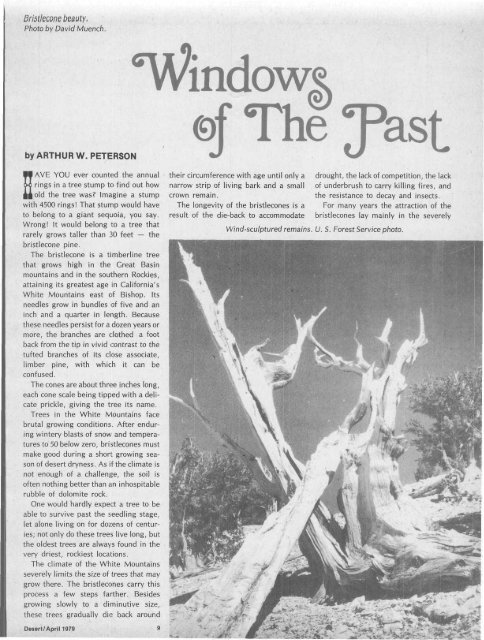Come - Desert Magazine of the Southwest
Come - Desert Magazine of the Southwest
Come - Desert Magazine of the Southwest
You also want an ePaper? Increase the reach of your titles
YUMPU automatically turns print PDFs into web optimized ePapers that Google loves.
Bristlewne beauty,<br />
Photo by David Muench.<br />
by ARTHUR W. PETERSON<br />
HAVE YOU ever counted <strong>the</strong> annual<br />
rings in a tree stump to find out how<br />
old <strong>the</strong> tree was? Imagine a stump<br />
with 4500 rings! That stump would have<br />
to belong to a giant sequoia, you say.<br />
Wrong! It would belong to a tree that<br />
rarely grows taller than 30 feet — <strong>the</strong><br />
bristlecone pine.<br />
The bristlecone is a timberline tree<br />
that grows high in <strong>the</strong> Great Basin<br />
mountains and in <strong>the</strong> sou<strong>the</strong>rn Rockies,<br />
attaining its greatest age in California's<br />
White Mountains east <strong>of</strong> Bishop. Its<br />
needles grow in bundles <strong>of</strong> five and an<br />
inch and a quarter in length. Because<br />
<strong>the</strong>se needles persist for a dozen years or<br />
more, <strong>the</strong> branches are clo<strong>the</strong>d a foot<br />
back from <strong>the</strong> tip in vivid contrast to <strong>the</strong><br />
tufted branches <strong>of</strong> its close associate,<br />
limber pine, with which it can be<br />
confused.<br />
The cones are about three inches long,<br />
each cone scale being tipped with a delicate<br />
prickle, giving <strong>the</strong> tree its name.<br />
Trees in <strong>the</strong> White Mountains face<br />
brutal growing conditions. After enduring<br />
wintery blasts <strong>of</strong> snow and temperatures<br />
to 50 below zero, bri stlecones must<br />
make good during a short growing season<br />
<strong>of</strong> desert dryness. As if <strong>the</strong> climate is<br />
not enough <strong>of</strong> a challenge, <strong>the</strong> soil is<br />
<strong>of</strong>ten nothing better than an inhospitable<br />
rubble <strong>of</strong> dolomite rock.<br />
One would hardly expect a tree to be<br />
able to survive past <strong>the</strong> seedling stage,<br />
let alone living on for dozens <strong>of</strong> centuries;<br />
not only do <strong>the</strong>se trees live long, but<br />
<strong>the</strong> oldest trees are always found in <strong>the</strong><br />
very driest, rockiest locations.<br />
The climate <strong>of</strong> <strong>the</strong> White Mountains<br />
severely limits <strong>the</strong> size <strong>of</strong> trees that may<br />
grow <strong>the</strong>re. The bristlecones carry this<br />
process a few steps far<strong>the</strong>r. Besides<br />
growing slowly to a diminutive size,<br />
<strong>the</strong>se trees gradually die back around<br />
<strong>Desert</strong>/April 1979 9<br />
'Windo<br />
©f The Tast<br />
<strong>the</strong>ir circumference with age until only a<br />
narrow strip <strong>of</strong> living bark and a small<br />
crown remain.<br />
The longevity <strong>of</strong> <strong>the</strong> bristlecones is a<br />
result <strong>of</strong> <strong>the</strong> die-back to accommodate<br />
drought, <strong>the</strong> lack <strong>of</strong> competition, <strong>the</strong> lack<br />
<strong>of</strong> underbrush to carry killing fires, and<br />
<strong>the</strong> resistance to decay and insects.<br />
For many years <strong>the</strong> attraction <strong>of</strong> <strong>the</strong><br />
bristlecones lay mainly in <strong>the</strong> severely<br />
Wind-sculptured remains. U. S. Forest Service photo.
















